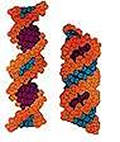| enginuity |
|
home | contents | previous | next |
Some secrets of life
The study of bacteria and DNA is not usually associated with engineering, but Professor Chris Calladine has applied his knowledge of structural mechanics in solving some fundamental problems in this area. It all started with wondering how the corkscrew shaped tails (flagellae) of bacteria, which act as tiny propellers, can possibly be constructed from a set of single identical building blocks - the protein flagellin - since identical building blocks in a tubular packing can normally build only straight rods.

Calladine addressed this fundamental question in some pioneering work with Aaron Klug, of the MRC Laboratory of Molecular Biology, in 1975. He showed that if the flagellin molecule contained just one "mechanical" bistable switching feature, then he could explain not only the construction of a corkscrew as such, but also the known ability of that corkscrew to change into a variety of other known helical forms in different physical circumstances. In principle, an assembly of identical three-dimensional mechanically bistable subunits can show surprising and subtle structural forms; and this feature is brilliantly exploited in nature.
Once it had become clear that the principles of structural mechanics could be used to answer such questions at a microscopic scale, Calladine developed further collaboration with Horace Drew, also of the MRC Laboratory, to answer fundamental questions regarding the structure of DNA.
Most people are now familiar with the idea that the molecular structure of DNA takes the form of a double helix, as first established by Francis Crick and James Watson in 1953: the base-pairs whose sequence spells out the genetic code are arranged like the treads of a staircase, held between the two spiral "backbones". What is not so well known is that in the laboratory DNA "switches" between two distinct double-helical forms as the moisture content changes. Calladine and Drew were curious about why there is a switching action here, rather than a continuous change between the two forms.
The key to the situation is that the double-helical structure is actually driven by the stacking of base-pairs on top of one another, with the "backbones" merely providing some constraints to the conformation. This "inside-out" view of DNA enables many sequence-dependent mechanical properties of DNA to he understood - such as curvature, stiffness, and modes of distortion upon binding DNA to protein. In their book 'Understanding DNA : the molecule and how it works' Calladine and Drew use the principles of structural engineering to explain many aspects of the physical performance of this complex molecule.
For further information, please contact Professor Chris Calladine: 01223 332725, e-mail: crc@eng.cam.ac.uk
| number 9, July 2000 | home | contents | previous | next |